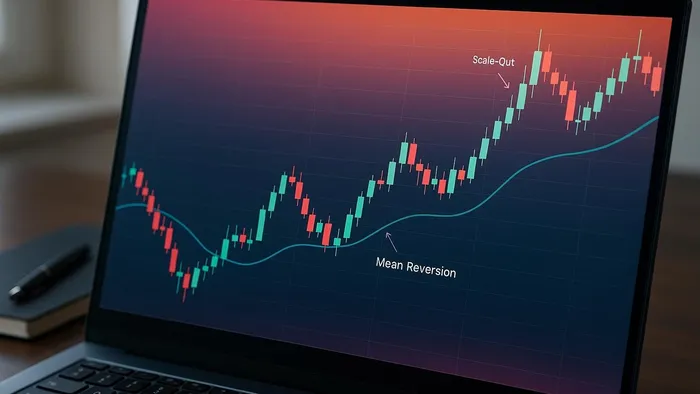Learn how to profit from mean reversion trading with effective strategies, scale-out exits, and robust risk management techniques.
Mean reversion trading is about profiting when prices return to their average after extreme moves. Here's what you need to know:
- Key Idea: Prices often revert to their historical mean after significant deviations.
- Entry Strategy: Use the fade method to trade against extreme price movements.
- Exit Strategy: Apply scale-out exits to lock in profits gradually as prices move back to the mean.
- Indicators: Tools like Bollinger Bands, RSI and divergence signals help identify potential reversals.
- Risk Management: Use volatility-based position sizing and stop-loss orders to limit losses.
For example, in April 2025, Bitcoin’s price dropped significantly but rebounded after showing bullish divergence on the RSI — highlighting the importance of combining technical tools with disciplined trading methods. LuxAlgo tools can further simplify finding and managing these opportunities.
Finding Mean Reversion Trade Setups
Statistical Analysis Tools
Mean reversion trading revolves around identifying statistically significant price shifts. To do this effectively, traders often rely on a mix of indicators to pinpoint potential reversal points.
One of the most widely used tools is Bollinger Bands, which highlight when prices deviate beyond two standard deviations. Such deviations often suggest a higher likelihood of prices reverting to the mean. The effectiveness of Bollinger Bands increases when paired with momentum indicators like the Relative Strength Index (RSI).
| Indicator Combination | Signal Strength | Usage |
|---|---|---|
| Bollinger Bands + RSI | High | Enter trades when price hits the outer band and RSI exceeds 70 or drops below 30 |
| MACD + Price Action | Medium | Look for divergence near clear support or resistance levels |
| Multiple Time-frame RSI | Very High | Confirm overbought or oversold conditions across various time-frames |
A real-world example highlights this synergy. In April 2025, Bitcoin’s price dropped to around $81 256, forming lower lows. Meanwhile, the RSI showed higher lows, signalling a bullish divergence. This setup preceded a rally that pushed Bitcoin above $87 000.
For traders looking to streamline this process, automated tools can simplify the detection of these signals.
LuxAlgo Signals & Overlays – Trend Tracer

The Signals & Overlays (S&O) toolkit includes the powerful Trend Tracer feature, designed to give traders clear, real-time feedback on market direction:
- Dynamic Baseline – Trend Tracer plots an adaptive baseline that adjusts to volatility, smoothing out noise while keeping pace with sudden market shifts.
- Colour-coded Candles – The toolkit automatically shades candles green or red to reflect bullish or bearish bias, helping traders spot when price and trend are out of sync.
- Deviation Alerts – When price stretches a set distance from the baseline, S&O flags potential exhaustion, offering mean-reversion traders a heads-up that extremes may soon revert.
- Multi-time-frame Confirmation – Overlay additional Trend Tracer signals from higher time-frames to validate the bigger picture before acting on lower-time-frame entries.
By automating trend identification and highlighting over-extended moves, the S&O toolkit removes guesswork and gives mean-reversion traders greater confidence in timing fade entries and exits.
Divergence Signals with LuxAlgo
Divergence signals are another essential component of mean-reversion strategies. Tools like the Oscillator Matrix help traders identify divergences early, providing critical confirmation for potential reversals.
For instance, between 14 and 16 April 2025, the EUR/USD forex pair showed bearish divergence. While prices made higher highs near 1.05322, the RSI registered lower highs. This divergence signalled a downward move, with prices eventually dropping below 1.04000.
Here’s a quick overview of divergence types and their implications:
| Divergence Type | Price Action | Indicator Movement | Signal |
|---|---|---|---|
| Regular Bullish | Lower lows | Higher lows | Possible upward reversal |
| Regular Bearish | Higher highs | Lower highs | Possible downward reversal |
| Hidden Bullish | Higher lows | Lower lows | Continuation of upward trend |
| Hidden Bearish | Lower highs | Higher highs | Continuation of downward trend |
Back-testing data further validates the importance of divergence in mean-reversion trading. For example, an analysis of the S&P 500 showed a profit factor of 1.75 or higher when trading divergences with holding periods ranging from 2 to 20 days. This reinforces the value of combining divergence signals with other technical tools for well-timed trade decisions.
Fade Entry Methods
Fade Entry Rules
To execute successful fade entries, traders need a structured approach that uses statistical evidence to identify extreme price movements likely to reverse.
An effective fade entry strategy is built on three main pillars:
- Statistical Deviation Confirmation
Ensure price deviations exceed 1.5 standard deviations, aligning with the statistical principles discussed earlier. - Momentum Assessment
Reliable setups often emerge when:- The RSI exceeds 70 (indicating overbought conditions) or drops below 30 (indicating oversold conditions).
- Prices break outside the Bollinger Bands.
- Additional indicators suggest weakening momentum.
- Market Context Analysis
It’s crucial to understand the broader market environment. Look for confirmation through overall price action and supporting technical setups before committing to an entry.
| Fade Entry Condition | Required Signal |
|---|---|
| Price Extension | > 1.5 standard deviations |
| RSI Signal | Extreme readings to signal reversal potential |
| Volume Pattern | Evidence of declining volume |
| Price Action | Reversal candlestick patterns |
These foundational rules can be further enhanced with automated tools to fine-tune entry timing.
Entry Signals with LuxAlgo
LuxAlgo’s Signals & Overlays toolkit simplifies the process by automating the identification of ideal reversal zones. It monitors real-time deviations, incorporates volume profiles to highlight exhaustion zones and utilises the Oscillator Matrix to confirm divergences.
Key steps for effective execution include:
- Waiting for clear confirmation signals before entering a position.
- Using multiple time-frame analysis to strengthen confidence in reversal potential.
- Gradually scaling into positions instead of committing to full-size entries upfront.
- Placing stop-loss orders beyond recent swing points to avoid premature exits.
Patience and discipline are critical for improving entry accuracy and optimising risk-reward ratios.
10 Mean Reversion Trading Strategies
Scale-Out Exit Techniques
Scale-out exit strategies are all about balancing profit-taking and risk management. By gradually reducing your position as price targets are met, you can lock in profits while still leaving room for potential upside. These methods work best when paired with precise entry strategies, ensuring you stay in control of your trades.
Multiple Profit Targets
Breaking your exits into stages allows you to secure gains while keeping some exposure for further price movements. Here's how a systematic approach to profit targets might look:
- Initial Target: Sell 30-40 % of your position once the price hits the mean.
- Secondary Target: Exit another 30-40 % as the price moves further in your favour, such as 1.5 standard deviations beyond the mean.
- Final Target: Hold onto the remaining 20-30 % for larger moves or until a clear reversal signal emerges.
| Exit Stage | Position Size | Target Criteria |
|---|---|---|
| First Exit | 35 % | Price reaches the mean |
| Second Exit | 35 % | About 1.5 standard deviations past the mean |
| Final Exit | 30 % | Technical reversal signals |
In addition to these preset targets, you can use dynamic stops to protect your gains as the market evolves.
Trailing Stop Methods
Trailing stops are a great way to lock in profits while letting your trade run. Adjusting stop distances based on volatility and position size helps you stay flexible. Here are some general guidelines:
- Start with wider stops, such as 8-12 %, especially for short-term trades.
- Tighten your stops as profits grow — for example, narrowing them to 0.25-0.40 % when the trade becomes significantly profitable.
- Use the asset’s Average True Range (ATR) to set stop distances during periods of high volatility.
Example: Let’s say you buy 600 shares at $90.13. You might start with an initial stop at $89.70. As the trade moves in your favour, progressively adjust your trailing stops to $0.49, $0.40, and finally $0.25. If you exit at $91.70, you’d lock in a $942 profit, a 1.74 % return.
These techniques allow you to adapt your exit strategy in real time, maximising gains while protecting against reversals.
LuxAlgo AI Exit Testing
The LuxAlgo AI Backtesting Assistant is LuxAlgo’s AI agent for creating trading strategies and refining scale-out exits. It lets traders test various combinations of profit targets, trailing stops and exit timing across multiple time-frames. This data-driven approach reduces emotional decision-making and promotes more-consistent results.
Here’s how to combine AI insights with real-time market analysis for better exits:
- Use the Oscillator Matrix to confirm divergences at exit points.
- Keep an eye on volume patterns to validate your timing.
- Analyse momentum across different time-frames for a well-rounded exit plan.
Risk Control Methods
Volatility-Based Position Sizing
Volatility-based position sizing (VBPS) is a method that adjusts your trade size based on market volatility. This approach helps you avoid over-exposure during volatile periods and allows for larger positions when market conditions are more stable.
Here’s a practical example of VBPS in action:
| Portfolio Size | Risk Per Trade | Stock Price | ATR (14-day) | Position Size |
|---|---|---|---|---|
| $100 000 | 1 % ($1 000) | $50 | $2 | 500 shares |
| $100 000 | 1 % ($1 000) | $50 | $4 | 250 shares |
Formula: Position Size = Risk Amount / (Volatility Measure × Price)
Key considerations when using VBPS:
- Use the Average True Range (ATR) as your primary measure of volatility.
- Adjust position sizes inversely to volatility — smaller positions during high volatility and larger ones when volatility is low.
- Keep your risk exposure consistent across trades.
- Reduce position sizes during periods of heightened market turbulence.
Pair these adjustments with well-placed stop-loss orders to create a comprehensive risk-management plan.
Stop-Loss Placement with LuxAlgo
LuxAlgo provides advanced tools to refine your stop-loss strategy. Utilising its Signals & Overlays toolkit (in conjunction with price-action tools if needed), you can pinpoint critical support and resistance levels to determine the best stop-loss placements.
Here’s a guide to essential risk parameters for mean-reversion trades:
| Risk Element | Recommended Limit | Purpose |
|---|---|---|
| Per Trade Risk | 1 % of total capital | To prevent significant losses |
| Portfolio Risk | Varies by strategy | To manage overall exposure |
| Stop Loss | Set before trade entry | To limit potential losses |
Tips for effective risk control:
- Regularly monitor trades for any breaches of the expected price range.
- Tighten stop-loss levels during volatile market conditions.
- Use LuxAlgo tools to identify key market-structure points, such as support and resistance levels.
- Spread your capital across multiple uncorrelated mean-reversion setups to minimise concentrated risk.
Conclusion
Achieving success in mean-reversion trading hinges on precise entry timing, well-planned scale-out exits, and disciplined risk management. These elements help traders take advantage of price deviations while protecting their capital.
Fade entries, combined with scale-out exits, have shown strong results in range-bound markets. For instance, back-tests reveal win rates as high as 73 %, with average profits reaching 0.88 % per trade between 2001 and 2025.
Tools like LuxAlgo’s Market Breadth Toolkit make identifying mean-reversion opportunities more efficient. A notable example occurred in April 2025 when the Zweig Breadth Thrust indicator signalled a bullish setup on the daily chart, reinforcing potential reversal opportunities. Such resources complement fundamental trading practices.
Critical components of success include using risk-adjusted position sizing, setting multiple profit targets with trailing stops for strategic exits, and confirming setups through multiple technical indicators.
“Managing risk is indispensable for successful statistical mean-reversion trading. By controlling correlation, volatility, diversification, and optimising risk-adjusted returns, traders can overcome the inherent challenges in mean-reversion strategies. Take a quantitative approach to honing your edge from both a risk and return perspective.”
While mean-reversion strategies thrive in range-bound markets, they require adjustments during strong trending conditions. Staying disciplined with risk management and utilising advanced tools can help traders maintain their edge over time.
FAQs
How can I use the LuxAlgo PAC toolkit to find mean reversion opportunities in volatile markets?
To pinpoint mean reversion opportunities in turbulent markets with the LuxAlgo PAC toolkit, begin by utilising the Reversal Zones feature. This tool identifies areas where prices have strayed far from their average, helping you spot potential turning points with clarity.
Additionally, the PAC Backtester allows you to review historical performance and test your mean-reversion strategies. To refine your accuracy, pair these tools with volume indicators, which can confirm market strength and possible reversals. When combined, these features offer a strong framework for navigating volatile market conditions.
How should I set stop-loss orders when using volatility-based position sizing in mean reversion trading?
When setting stop-loss orders in mean-reversion trading while using volatility-based position sizing, it's important to keep a few essential factors in mind:
- Market Volatility – Tailor your stop-loss to the asset’s volatility. For more volatile assets, wider stop-loss levels may help you avoid getting stopped out by normal price swings.
- Technical Levels – Position your stop-loss just beyond key support or resistance zones. This helps prevent routine price movements from prematurely closing your trade.
- Risk-Reward Ratio – Make sure your stop-loss fits within a sensible risk-reward framework, like 1:2 or 1:3. This approach ensures the potential reward outweighs the risk you’re taking.
Balancing these elements can help you manage risk effectively while giving your trades the space they need to play out within the anticipated price range.
How can scale-out exit strategies help traders manage risk and maximize profits in mean reversion trading?
Scale-out exit strategies give traders a way to gradually reduce their position as prices move in their favour. This approach strikes a balance between securing profits and managing risk effectively. Instead of closing out a trade all at once, traders sell portions of their position at specific price levels, locking in gains while keeping the door open for further potential upside.
This strategy also helps lower overall exposure as profits are taken, which can be especially handy in volatile markets. For mean-reversion trading — where prices tend to bounce around a central value — scaling out offers the flexibility to adjust to market shifts while sticking to a disciplined plan for balancing risk and reward.
References
- Reversal Spotting Made Easy – LuxAlgo Blog
- LuxAlgo Home Page
- Oscillator Matrix Reversal Signals – LuxAlgo Docs
- LuxAlgo Toolkits Overview
- Trend Tracer – Signals & Overlays Docs
- Oscillator Matrix Introduction – LuxAlgo Docs
- Understanding RSI – LuxAlgo Blog
- Volumetric Toolkit – LuxAlgo Library
- Reversal Candlestick Structure – LuxAlgo Library
- Oscillator Matrix Reversal Signals – Advanced Docs
- Fibonacci Trailing Stop – LuxAlgo Library
- Range Average Retest Model – LuxAlgo Library
- AI Backtesting Assistant – LuxAlgo
- Risking It Right – LuxAlgo Blog
- Targets For Many Indicators – LuxAlgo Library








